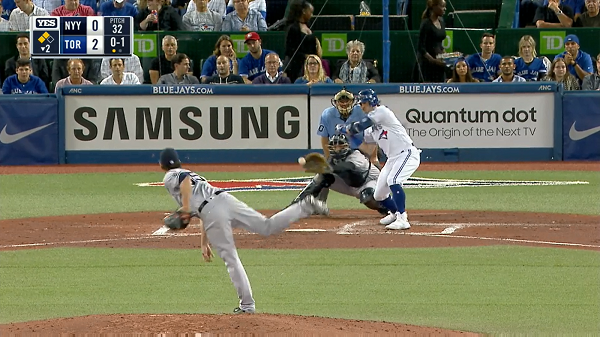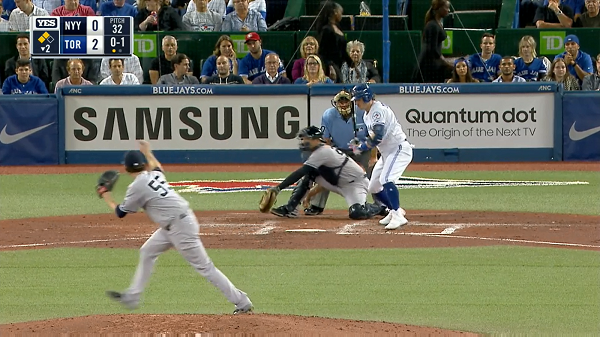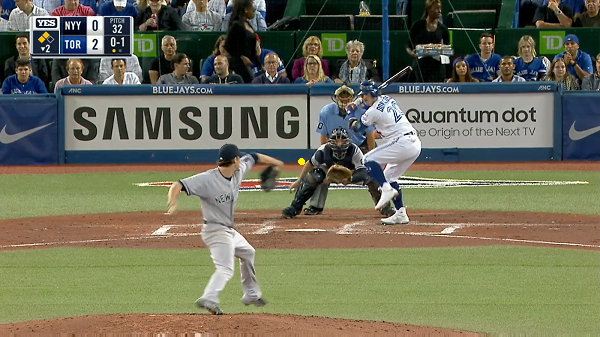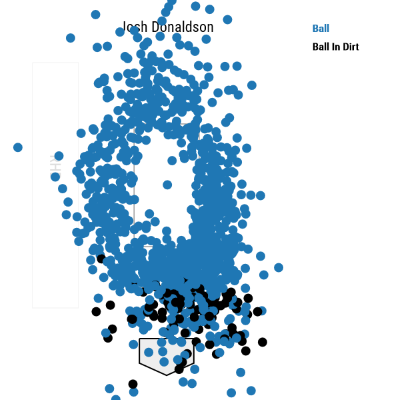The Worst Called Ball On Record
Last Monday, in what was a pretty critical game against the Mariners, Josh Donaldson got ejected in the seventh inning. Officially, he was ejected for arguing balls and strikes, but, unofficially, he was ejected for being a jerk. During his seventh inning at-bat, Donaldson tried to check a swing, and he disagreed with the determination that he didn’t check it enough. A couple pitches later, Donaldson was called out on a pitch that was probably below the zone. That was too much, and Donaldson expressed himself, and that was that. Donaldson wasn’t likely to hit again, so the ejection didn’t mean much, but he felt like he was getting screwed. Josh Donaldson belligerently wondered aloud why he couldn’t catch a break.
If only he knew then what he might know now. I don’t want to say that Donaldson deserved a break. A grown man needs to be able to control himself. But borderline calls are luck, and given enough time, luck will even out. Several days ago, Josh Donaldson felt like he was unfairly struck out. Friday night in Toronto, Donaldson was in the box for the very worst called ball of the entire PITCHf/x era.
I didn’t see this happen live — I was otherwise occupied. Yet one of the realities of this sort of job is that you’re pretty frequently checking in with Twitter. Now, ordinarily, when I’m not actively tweeting, I don’t get a lot of activity. People tend not to seek me out. But when I pulled up Twitter last night and refreshed, I saw I had dozens of new mentions. That’s uncommon, and instantly, I knew it could mean only one thing. Someone, somewhere, had blown a pitch call.
And, I mean, God damn.
Call helps #BlueJays
Ball 1 should be strike 2
Bot 2 Mitchell vs Donaldson
0% call same
9.6in from edge pic.twitter.com/EwdrhjlLH4— BlueJays Strike Zone (@BlueJaysUmp) September 23, 2016
There are a lot of these automated Twitter bots. I haven’t checked to make sure, but it feels like there’s one for every team. They’re all reasonably popular accounts, because fans love to see when their complaints might be justified. Fairly often, these accounts will show a ball on a pitch down the middle. When those are brought to my attention, I look them up, and they’re mostly data glitches. They reflect things that didn’t actually happen. Just last night, I was forwarded two such tweets pertaining to pitches thrown by Chris Archer. In reality, something just got messed up; Archer didn’t get charged with two called balls down the pipe. But this pitch to Donaldson — this happened. It happened in the way that it’s shown. I was quickly able to confirm with screenshots and video. That was a called ball. This was a called ball.
The pitch was a fastball. It wasn’t dropped by the catcher, and the runners weren’t going. On the surface, there wasn’t anything deceptive. But, Bryan Mitchell threw Josh Donaldson an 0-and-1 fastball right down the gut. The count evened out. In one way, it was a bad break for Mitchell. In another, I suppose there are worse potential outcomes for a fastball you groove to the defending league MVP.
When I tackle these things, I like to calculate the distance of the pitch from the very center of the strike zone. Typically, when I look at the worst called balls of a given season, they’re removed from the middle by one or two inches. That’s basically nothing. But this pitch? According to the information from Baseball Savant, this pitch was 0.3 inches from being exactly middle-middle. According to the adjusted information from Brooks Baseball, this pitch was 0.6 inches from being exactly middle-middle. That’s it; that’s the worst called ball. I know all the data comes with a certain margin of error, but in the history of pitch-tracking, stretching back through 2008, we haven’t seen a worse called ball. Not by my calculations. This isn’t just the worst called ball of the season, then. This is the worst called ball of many seasons.
If you’re like me, you need an explanation. How does a call like this happen? Did Tom Hallion’s cell phone start to ring in his back pocket as the pitch was about to arrive? I guess I don’t really know what was happening in Hallion’s back pocket — I can’t totally rule that out. But I do think there’s a better explanation, and, to be honest, it’s the usual explanation. No umpire wants to call a ball on a pitch down the middle. This one, though, you can pin mostly on Austin Romine. The video is damning.
It can be hard to identify precisely what makes a good pitch-receiver a good pitch-receiver. There are so many little subtleties, and they can be difficult to detect. Yet it’s not always hard to identify what makes a bad pitch-receiver. I don’t mean to suggest that Romine is always bad. The numbers think he’s fine enough. But Romine screwed this one up. If you want to know the wrong way to receive a pitch, catch the pitch with your glove in motion, and allow your entire body to drift toward the opposite batter’s box.
Here is where Romine made the actual catch:
That’s where the catch had to be made — that’s where the pitch was, after all. Literally right down the middle. Yet skip ahead just a few frames:
Romine’s shoulders are almost perpendicular to the umpire. The glove makes it look like Romine was trying to catch a pitch that would probably hit Anthony Rizzo. In theory, absolutely, the umpire wants to arrive at a decision based only on where he thought the ball was as it entered the zone area. It shouldn’t make a difference what happens after the ball passes by the batter’s body. But this all takes place in a fraction of a fraction of a second. You can’t help but be influenced. You can’t not notice when a catcher flops around like a fish in a rowboat. And when a catcher moves that much, what it implies is that the pitch must’ve been bad. Ball one.
You could try to argue that maybe Romine was crossed up. So that could have something to do with Mitchell. And, you know, maybe; there was a runner on second and I’m not going to try to decode the Blue Jays’ pitch signs. But Romine set up for a pitch inside:
Against righties, Mitchell throws pretty much exclusively hard pitches inside. So I don’t think this was miscommunication. Another argument: Shouldn’t Mitchell be at least partially blamed for missing his spot? I mean, the actual pitch wasn’t inside. Here’s the target, and then the eventual location, marked by the yellow dot:
It’s true that Mitchell didn’t locate how he wanted. So he’s not totally blameless. But that’s a miss by, what, a foot? Previous research has indicated that the average major-league pitch misses its target by roughly a foot. So while Mitchell missed, I wouldn’t say the pitch was wild. Maybe Mitchell gets…20% of the blame. Maybe Hallion gets another 20%? That would leave Romine with 60%. You can move the numbers around a little bit, since I’m just estimating an intangible, but Romine should always stand as the biggest factor.
Here’s how it looked on Gameday, which, well, I guess you already know this was a pitch down the middle.
Meanwhile, here are all of the balls called for Donaldson in 2016. This image comes from Baseball Savant. There are some bad balls in there. One stands out in particular.
What happened Friday in the second inning gave me maybe my favorite GIF of the year.
The pitch shows up, and then there’s a pause. It still has to be colored and classified by result. Bright blue. I have no idea whether that’s automated or generated by a person, but if that was manually entered, I imagine the delay was due to the graphics guy placing an urgent call to the commissioner.
That little box was in the corner of the TV broadcast. Blue Jays television said nothing. This, I’ll remind you, was the worst called ball in recent history. And it happened early in the second inning of a meaningful game. But those broadcasters weren’t alone. Yankees television said nothing. Yankees radio said nothing. Yankees Spanish-language radio said “afuera,” so they were also confused by Romine. Did this pitch call somehow go by without remark? Thankfully, no. Blue Jays radio was on it. Or, Joe Siddall was on it. Jerry Howarth, not so much.
Howarth: Stretch — and the rookie’s pitch, outside, backhanded nicely by the catcher Romine. One ball and one strike.
Siddall: Andrew Romine took that pitch right out of the zone. It was a good fastball from Mitchell in the mid-90s but the way he caught that on his backhand, he just took that right out of the zone, almost as though the pitch was a foot outside.
Howarth: Mitchell looks in —
You couldn’t have two more opposite perspectives back-to-back. Howarth went so far as to praise Romine for the way he handled a pitch outside. Siddall, meanwhile, accurately described the reality of what took place. This is a radio broadcast, so, in theory, it’s responsible for painting the whole picture. The listener would have no idea which guy might’ve been telling the truth. But, Howarth didn’t dig his heels in. He didn’t try to defend himself. He didn’t even verbally acknowledge Siddall’s correction. It just kind of hung there. But, you could say Siddall got in the last word. And he’s the one who used to be a major-league catcher. Point, Joe Siddall. Except for the whole thing where he named the wrong Romine.
There we have it. Seemingly the worst called ball in at least nine years. According to tracking technology, the pitch missed the exact center of the strike zone by less than one inch. You might wonder, wait, what was Josh Donaldson doing taking this pitch in an 0-and-1 count? Isn’t this precisely the pitch a hitter should be looking for? You don’t get a called ball like this without multiple screw-ups. There’s plenty of blame to go around.
Jeff made Lookout Landing a thing, but he does not still write there about the Mariners. He does write here, sometimes about the Mariners, but usually not.







Wins Above Romine = WAR version that factors in framing.